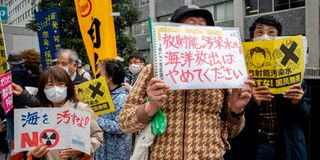Shelve nuclear power, go for cleaner alternatives

A protest in Japan against nuclear waste.
What you need to know:
- Globally, levelised costs of nuclear power have increased by 23 per cent.
- In comparison, utility-scale solar and wind have fallen 88 per cent and 69 per cent, respectively.
In October 2020, the Nuclear Power and Energy Agency (NuPEA) yet again delayed nuclear development plans, deferring a 1,000 megawatt commercial plant to 2036 over “logistical hurdles”. But the postponement now looks like a pattern, the agency having first pushed its 2022 plans to 2025 and then 2027. Originally aiming to produce 4,200 MW by 2022, the delay is blamed on lengthy compliance procedures, preparation of legal and regulatory frameworks and capacity building, among others.
Proponents view nuclear energy as a cost-effective way to lower power costs, stabilise electricity supply, cut carbon emissions and diversify Kenya’s energy sources with more reliant power during drought. NuPEA and key political actors view commercial nuclear power as a one-stop solution to the electrification woes — a case of the sunk cost fallacy. They view small reactors as “cheaper and faster to implement”, which could satisfy electricity demand, seen to grow by seven per cent annually after this year.
NuPEA estimates a seven-year construction timeline with resources for training, studies, stakeholder engagement and public support. But that is unlikely: The average time worldwide since 2009 is just under 10 years, excluding planning and financing.
Secondly, political stability is a precondition for international vendors and institutions to lend financing and/or support to the programme. Kenya has cycled through post-election crises, the latest in 2007.
A state-driven “solution” by amending the 11-year-old Constitution is before the Court of Appeal after the High Court declared it unconstitutional. Relying on the Judiciary to uphold a liberal democracy that becomes fragile during elections is not a good for a state eyeing a long-term nuclear power programme.
Solar resources
Lastly, nuclear energy is among the most expensive. The only reactors under construction in North America are forecast to cost $29 billion (Sh2.9 trillion), up from the initial $14 billion. Globally, levelised costs of nuclear power have increased by 23 per cent. In comparison, utility-scale solar and wind have fallen 88 per cent and 69 per cent, respectively.
While NuPEA contends it can build a 1,000 MW plant at $5 billion, the Kenya Least Cost Power Development Plan 2011-2031 identified nuclear and coal power as costlier than other options and geothermal the least-cost choice technology.
Moreover, Kenya ranks among the top 10 Sub-Saharan African countries on solar resources, while solar power can most benefit marginalised groups and small-scale users. Kenya also has one of the highest on-shore wind potential in Africa and hosts the continent’s largest wind power plant. It ranks seventh globally in geothermal power generating capacity.
Amid plans for 100 per cent green energy through scaled-up renewable energy investment, Kenya Vision 2030 has already pushed ambitious goals for solar and wind with plans of 600 MW by 2030 and 2,500 MW by 2035, respectively. It’s in our interest to double down on the cheaper renewable energy. That will be fiscally prudent, save time to meet electricity demand and meet climate objectives.
Mr Edou is a Master of Public Policy and Global Affairs student at the University of British Columbia in Vancouver, Canada. [email protected]. @edwinaedou





